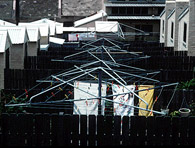
Hills clothes hoist
1948
rotary clothes line
Lance Hill's clothes hoist became a symbol of Australian home life in the 1950s but Lance Hill did not invent the rotary clothes hoist. Gilbert Toyne patented one in Adelaide in 1926, which was sold in small numbers until the early 1960s.
In 1945 Lance Hill returned to Adelaide from war. His wife complained that her traditional clothesline between two posts (propped up in the middle by a stick) was in the way of the lemon tree. Hill's answer was to design a compact rotary line out of metal tube and wire. He was unemployed and turned his idea into a livelihood.
His first batch was made with tubing salvaged from the frame of the underwater boom that had hung under the Sydney Harbour Bridge to catch enemy submarines during World War II.
He designed a cast aluminium winding gear to hoist the line up into the breeze - and the Hill's hoist was born ... at just the right time and place to become spectacularly successful.
Hills Industries has now expanded and diversified. It has acquired several different companies and produces many different products, eg, clothes lines, ironing boards, wheelbarrows, antennas, CCTV equipment and systems, building and roofing products to name a few.
They have manufacturing plants in the UK and New Zealand. Products are sold in Hong Kong, Singapore, Malaysia and SE Asia, and trade links exists with many countries including Scandinavia, Austria, Hawaii, Greece, Papua New Guinea and Burundi in the African continent.
Toyne may have invented the rotary hoist, but it was Hill's entrepreneurial flair and the huge boom in house-building after World War II that made his big metal tree for drying clothes into an icon of suburbia.
Who Did It?
Key Organisations
Hills Industries : design, manufacture
Key People
Lance Hill : developer
Harold Ling : brother-in-law, developer
Further Reading
What a line! : the story of the people who made the hoist an Australian icon : fifty years of Hills
David Harris
Hills Printing Services, Melrose Park, SA, 1996.
Links
Hills Industries
Hills
Hoist patent example
Clothes
drying and renewable energy
|










